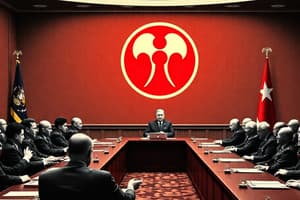Podcast
Questions and Answers
Match the following events with the correct years:
Match the following events with the correct years:
Sputnik's launch by the Soviet Union = 1957 Explorer I launched by the U.S. = 1958 First man in space by the Soviet Union = 1961 Neil Armstrong lands on the moon = 1969
Match the following individuals with their roles in the Space Race:
Match the following individuals with their roles in the Space Race:
Wernher von Braun = Designed Explorer I for the U.S. Army Alan Shepard = First American man in space John F. Kennedy = Made the goal to land a man on the moon by end of decade Neil Armstrong = First man to set foot on the moon
Match the following terms with their definitions:
Match the following terms with their definitions:
Sputnik = World's first artificial satellite Space Race = Competition between U.S. and Soviet Union in space exploration NASA = Federal agency dedicated to space exploration Explorer I = U.S. satellite designed by Wernher von Braun
Match the following countries with their roles in space exploration:
Match the following countries with their roles in space exploration:
Match the following terms with their definitions:
Match the following terms with their definitions:
Match the following events with their descriptions:
Match the following events with their descriptions:
Match the following consequences with their causes:
Match the following consequences with their causes:
Match the following impacts on American domestic life with their reasons:
Match the following impacts on American domestic life with their reasons:
Study Notes
The Cold War and Pop Culture
- The 1950s and 1960s saw a surge in popular films depicting nuclear devastation and mutant creatures, reflecting the Cold War's presence in everyday American life.
The Space Race
- On October 4, 1957, the Soviet Union launched Sputnik, the world's first artificial satellite, into Earth's orbit, surprising and alarming Americans.
- The United States responded with the launch of Explorer I in 1958, marking the beginning of the Space Race.
- In 1958, President Dwight Eisenhower established the National Aeronautics and Space Administration (NASA) to oversee space exploration and military space programs.
- The Soviet Union launched the first man into space in April 1961, followed by the first American man in space, Alan Shepard, in May 1961.
- President John F. Kennedy publicly declared that the United States would land a man on the moon by the end of the decade, a goal achieved on July 20, 1969, with the Apollo 11 mission.
The Atomic Age
- The National Security Council Report NSC-68 (1950) recommended a massive increase in defense spending to counter communist expansion, leading to an unprecedented arms buildup in the United States.
- The Soviet Union tested its first atom bomb in 1949, prompting the United States to develop the hydrogen bomb (H-bomb) in response.
- The first H-bomb test in 1952 demonstrated the devastating power of nuclear weapons, with a 25-square-mile fireball, ocean floor destruction, and the ability to destroy half of Manhattan.
- Subsequent American and Soviet nuclear tests contaminated the atmosphere with radioactive waste, heightening the threat of nuclear annihilation.
Impact on American Life
- The fear of nuclear war led to the construction of bomb shelters in backyards and the practice of attack drills in schools and public places.
Studying That Suits You
Use AI to generate personalized quizzes and flashcards to suit your learning preferences.
Description
Test your knowledge on the containment strategy and the unprecedented arms buildup in the United States during the Cold War's Atomic Age. Learn about the National Security Council Report known as NSC-68 and the call for a four-fold increase in defense spending.




